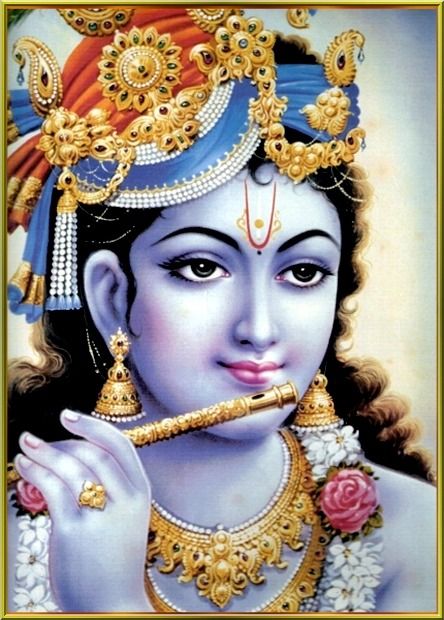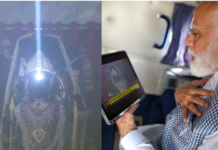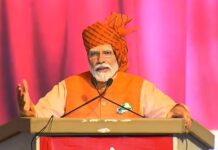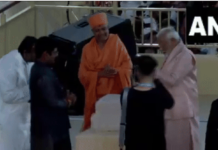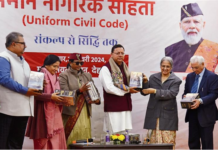This nazm is by Hafeez Jalandhari, the Urdu poet most well-known for composing the lyrics to Pakistan’s national anthem, the Qaumi Taranah. Born in the Punjabi city of Jalandhar (now in India), he moved to Lahore following India and Pakistan’s independence and Partition in 1947.
As its title suggests, Krishn Kanhaiya is a poem about the Hindu god Krishna. Today, the mere idea of a Muslim poet writing about a Hindu deity raises all sorts of emotions among different groups in South Asia: surprise, joy, curiosity, suspicion, anger.
However, there is much more depth to Krishn Kanhaiya than meets the eye. This is no ordinary devotional poem. Jalandhari, ever a politically-minded thinker and writer, draws upon the mythology and persona of Krishna in order to produce a poem that is simultaneously devotional and political in nature.
It is, in fact, a call to liberate India from British colonial rule. Moreover, this poem, especially when examined in comparison with Jalandhari’s more famous work, the Qaumi Taranah, can tell us a great deal about the cultural politics of South Asia in the 20th century and today.
Setting the scene
Let’s begin with a close reading of Krishn Kanhaiya.
In the very first line of the poem, Jalandhari addresses his readers as onlookers (dekhne wālo). Although this may seem trivial, I believe there is a deeper significance to this choice of words. Urdu poetry is usually meant to be heard, not read silently. One popular type of poetry, the ghazal, is sung, while nazms (of which Krishn Kanhaiya is one) are usually recited. Yet, Jalandhari chooses dekhne wālo, “those who look,” to characterise the consumer of this poem.
Could Jalandhari’s choice of words be referring to the importance Hinduism gives to seeing God? I don’t think it would be inaccurate to describe Hinduism as a religion which, among the fives senses, gives primacy to sight as a way of connecting to the Divine.
The central act of devotion when one goes to a Hindu temple is darshan: gazing upon the decorated image of the deity. And, of course, the incredibly intricate and symbolic iconography of Hindu gods and goddesses suggests the importance of saguna brahman, God With a Form.
By addressing the readers of the poem as “onlookers” instead of “listeners” or “readers,” Jalandhari might be encouraging them to engage in an act of darshan in their mind. As they read or hear the poem, he encourages them to also visualise Krishna in their minds.
But, where is Krishna in the poem? We haven’t gotten there yet. The opening lines are quite abstract. After asking whether Krishna is “reality or representation” (ma’anī hai ki sūrat), Jalandhari refers to Krishna as as a “form of light” (paikar-e-tanvīr), and asks “Is he fire or light?” (yeh nār hai yā nūr).
Again, these descriptions are full of meaning. In an article on Firstpost, Sharjeel Imam and Saquib Salim suggest that Jalandhari is alluding to Krishna as a being of light, reiterating “the age-old belief of a section of Islamic scholars, that Krishna was a righteous prophet sent to the people of the subcontinent.”
Jalandhari finally gives a description of Krishna that most Hindus would be familiar with: “this flute player / this cowherd of Gokul” (yeh bāñsurī wālā / gokul kā gwālā).
At the same time, Krishna is praised using the most typical Urdu expressions and words relating to God: “By God, what glory!” (kyā shān hai wallāh) and “he is the Majesty of God” (ik shān-e-ḳhudā hai). Jalandhari differs from traditional Hindu viewpoints in that he does not equate Krishna with God; yet, for him, Krishna is an embodiment of God’s glory and majesty.
Entering the idol
Echoing the earlier point about darshan and the importance of sight in Hinduism, Jalandhari displays a very intimate understanding of Hindu idol worship in the tenth stanza of the poem. He writes that “Inside the temple / the sculptor of beauty himself / entered and became the idol”.
This last line, that Krishna “entered and became the idol” (but ban gayā ā kar) is extremely important. Hindus worship idols as symbols of a deity’s presence in the sanctum sanctorum of a temple. The deity is not simply the physical statue; rather, devotees believe that God is present within that statue, and that presence is what makes an idol worthy of worship.
In Hindu temples, before a new image or statue is worshiped as a deity, a ritual called prana-pratishta is usually performed, to invoke that deity’s presence in that statue. Traditionally, the deity’s eyes were not fully carved until this ritual was performed. Before prana-pratishta, the statue is merely a statue. Afterwards, the god or goddess is seen as residing within that statue. Jalandhari’s line about Krishna “entering” the idol is thus a clear insight into Hindu temple worship.
On the banks of the Yamuna
Finally, we now get a glimpse of the leela (divine play) narratives that Krishna is so commonly associated with. Jalandhari describes Krishna’s youthful, romantic dancing and playing with the gopis (cowherd girls) on the banks of the Yamuna river as “rare happenings” (turfa nazzāre). In setting this scene, natural and sensual beauty are intertwined, as seen in phrases like “intoxicated winds” (sarmast hawāyeiñ) and “waves of love” (ulfat kī tarañgeiñ).
In his description of Krishna’s leela with the gopis, Jalandhari describes the sound of Krishna’s flute as “neither intoxication nor wine / it’s something beyond” (nasha hai na mai hai / kuchh aur hī shai hai). Through these charming vignettes, we, the onlookers, are also transported to Braj, dancing blissfully to the music of Krishna’s flute.
Humiliation in the Kaurava court
So far in the poem, Jalandhari has described Krishna’s glory, and then paints an idyllic scene of Krishna dancing with his gopis. Then, abruptly, the poem transitions into a much darker mood. Jalandhari takes us from the banks of the Yamuna to one of the most famous scenes from the Mahabharata epic.
The reader now finds themselves in the court of the Kaurava princes, the villains of the Mahabharata. This is the famous incident known as vastra-haran or cheer-haran (both roughly meaning “disrobing”). After the five Pandava brothers lose in a rigged dice game to their cousins (the Kauravas), they are forced to forfeit their kingdom, possessions, and eventually their wife Draupadi as their “property.”
Duryodhana, the eldest Kaurava, orders Draupadi to be brought into court and disrobed, to humiliate her. When Draupadi is dragged into the court, she prays to Krishna for help. Miraculously, Duryodhana and his brothers are unable to disrobe her. In some re-tellings, her sari is never-ending, and in others, when the Kauravas pull off one sarianother one appears in its place.
Draupadi praying to Krishna is not part of the critical edition of the Sanskrit Mahabharata, and was almost definitely added later as Krishna became a more popular deity across India. Nevertheless, it has become one of the most popular and iconic incidents from the Mahabharata. It is with this scene that Jalandhari begins to make his political views more explicit.
In the poem, the anguished Draupadi wails to Krishna, “These beloved princes [her husbands] / have all become cowards!” (yeh rāj dulāre / buzdil hue sāre). However, I wasn’t sure how to translate rāj dulāre; it could also have a much more pejorative sense, more like “royal babies.”
From this reading, we could guess that Jalandhari is accusing India’s numerous monarchs and rulers of princely states—all of whom eventually acquiesced to British rule—of cowardice. We could even read rāj dulāre as “babies of the [British] Raj!” This is Imam and Salim’s interpretation; they argue that Jalandhari is branding all Indians who worked under the British colonial administration as cowards, not just the royal families.
However, what is most telling is when Draupadi calls out to Krishna as “the light of India” (bhārat ke ujāle). In the poem, Krishna has morphed from being an abstract form of divinity, to a charming flute player in Vrindavan, and now he shines as a symbol of hope; the light of all of India. Jalandhari makes Krishna’s political symbolism much more salient from this point on.
Preparations for war
Jalandhari then takes us from the Kaurava court to the preparations for the great Mahabharata war. He writes that, worryingly, “Duryodhan seems victorious” (ġhālib hai duryodhan). Ostensibly, Duryodhana, the eldest Kaurava, is a symbol of foreign (British) rule over the subcontinent, which held sway for centuries. Ironically, while the Kaurava army was much larger than that of the righteous Pandavas, British citizens were vastly outnumbered by Indians all through colonial rule.
But, with Krishna’s arrival on the battlefield (on the side of the Pandavas, of course), everything changes. Once Krishna preaches the Bhagavad Gita to Arjuna, anxiety (tashvīsh) and sorrow (ġham) changes to war-like enthusiasm: “the divine decree has been pronounced / the sword has been swung!” (lo ban gayī taqdīr / lo chal gayī shamshīr)
The Krishna that Jalandhari describes now is different from the Krishna who dances with gopis. This Krishna is a symbol of strength and power: on his “face shines a bright gaze” (sūrat nazar-afroz), but his “virtues burn enemies” (sīrat hai adū-soz), and “If he gets angry / he strikes down lightning” (ġhusse meiñ jo ā jāye / bijlī hī girā jāye). This Krishna is, in short, an icon that can be easily used in service of anti-colonial nationalism.
A call to action
With this invigorated, confident Krishna in mind, Jalandhari now paints a picture of India suffering under colonial rule, using Vrindavan as a symbol for all of the subcontinent.
He takes us back to the banks of the Yamuna, which were full of beauty and joy during Krishna’s youthful lilas. What do they look like now? The Yamuna has become silent (sunsān), and its waves are weak and lacking in energy (josh). Once-beautiful gardens have been ruined (barbād), and the gopis (perhaps standing in for all people of India) have become distraught (pareshāñ) without Krishna’s presence.
Jalandhari now makes his own plea to Krishna: “Oh king of India / come just once more!” (ai hind ke rājā / ik bār phir ā jā) Interestingly, while Jalandhari makes Draupadi use the Sanskrit bhārat in her plea to Krishna, Jalandhari uses the Arabic/Persian hind when he is speaking in the poem.
He begs Krishna to return to Mathura (symbolising all of India) and restore his rule: “If you come, glory will come / if you come, life will come” (tū āye to shān āye / tū āye to jān āye). With this call for Krishna to liberate India from foreign rule, Jalandhari ends his nazm.
The Pakistan Question
Krishn Kanhaiya is one of Hafeez Jalandhari’s more obscure works. As I mentioned earlier, Jalandhari is known today largely because he wrote the lyrics for Pakistan’s national anthem. By comparing Krishn Kanhaiya to Jalandhari’s more famous work, I believe we can learn a lot about the cultural politics that have influenced South Asia over the past century, and continue to do so today.
Jalandhari’s Wikipedia page claims that before he moved to Pakistan, he was the director of the Song Publicity Department (it is unclear whether this was under the British colonial administration, or an Indian political party), and he wrote a number of popular songs during World War II.
He is described as an “active participant” in the Pakistan movement, and after independence in 1947 participated in India and Pakistan’s first war over Kashmir. For the rest of his life, Jalandhari was intimately involved with Pakistani military and government institutions: Director General of Morals for the Pakistan Armed Forces, Director of the Writers’ Guild of Pakistan, and a senior adviser to Pakistan’s second president, Ayub Khan.
I mention all of this simply because I find it fascinating that the same person could write both Krishn Kanhaiya and the national anthem of Pakistan. Each of these works represents a dramatically different worldview.
I do not intend to oversimplify Jalandhari’s worldview, but I would argue that Krishn Kanhaiya represents a deeply syncretic form of South Asian identity. In his poem, Jalandhari doesn’t just display a remarkable understanding of Krishna’s mythology, Hindu temple worship, and epics like the Mahabharata (which he all does very well); he even situates Krishna firmly within the Islamic tradition of prophets.
This is a cultural mode that the great Indian political psychologist Ashis Nandy describes quite eloquently in his essay in which the gods and goddesses of India inevitably find their way into other religious traditions, thus creating new, syncretic cultures and ways of existing. Nandy mentions the People of India census conducted by the Anthropological Survey of India between 1985 and 1994, in which 35 Indian communities described themselves as both Hindu and Muslim!
Final thoughts
What does it mean that the same person wrote both Krishn Kanhaiyaand the national anthem of Pakistan — works which have such radically different cultural rootings?
In the end, we are left with more questions than answers. Part of this is due to gaps in the historical record. Frustratingly, we don’t know when Krishn Kanhaiya was written, or in what written work it was published. Did Jalandhari write it before he became involved with the Pakistan movement and was exposed to the Two-Nation Theory? Did he write the poem after migrating from India to Pakistan? Without knowing these details, I admit that it is hard to make an argument about cultural politics using this poem.
However, one thing is very clear to me. The worldview that produced Krishn Kanhaiya is under threat. Extremists in both Indian and Pakistan thrive off the idea that Muslim and Hindu religious and cultural identities should be as separate and distinct as possible, with no room for overlap. Anyone who oversteps the boundaries set by fundamentalists is a target.
Let us ask ourselves: could a poem like Krishn Kanhaiya be written in today’s cultural atmosphere in South Asia? Despite all the negative forces of nationalism and fundamentalism, I believe that it still could.
Syncretism is by no means dead in South Asia. However, it will not operate on auto-pilot; when it comes to culture, nothing is guaranteed to last. It is up to us to make space for these cultural products that defy easy categorisation and exist purely in a state of hybridity. It is these cultural products which have the power to unify communities.
In these times, I too call out to Hafeez Jalandhari’s Krishna:
ai hind ke rājā, ik bār phir ā jā!
Oh king of India, come just once more!
Krishn Kanhaiya, by Hafeez Jalandhari
(I’d like to thank my friend Hamza Shad for helping me with this translation)
ai dekhne wālo
is husn ko dekho
is rāz ko samjho
O onlooker,
gaze upon this beauty;
try to understand this secret:
yeh naqsh-e-ḳhayālī
yeh fikrat-e-ālī
This figment of the imagination;
this grand thought.
yeh paikar-e-tanvīr
yeh krishn kī tasvīr
This form of light;
this image of Krishna.
ma’anī hai ki sūrat
san’at hai ki fitrat
Is he reality or representation?
Is he craft or nature?
zāhir hai ki mastūr
nazdīk hai yā dūr
yeh nār hai yā nūr
Is he apparent or hidden?
Is he near or far?
Is he fire or light?
duniyā se nirālā
yeh bāñsurī wālā
gokul kā gwālā
He’s an odd one,
this flute player;
this cowherd of Gokul.
hai sehr ki aijāz
khultā hī nahīñ rāz
This is a magical miracle;
this secret will not open.
kyā shān hai wallāh
kyā ān hai wallāh
By God, what glory!
By God, what dignity!
hairān hooñ kyā hai
ik shān-e-ḳhudā hai
I am perplexed by what he is;
he is the Majesty of God.
but-ḳhāne ke andar
ḳhud husn kā but-gar
but ban gayā ā kar
Inside the temple,
the sculptor of beauty himself
entered and became the idol.
woh turfa nazzāre
yād ā gaye sāre
jamunā ke kināre
Those rare happenings—
they’ve just come back to me—
Back on the banks of the Yamuna…
sabze kā lahaknā
phūloñ kā mahaknā
The plants waving in the breeze;
the fragrance of flowers…
ghanghor ghaTāyeiñ
sarmast hawāyeiñ
The dark rain-clouds,
the intoxicated winds…
ma’asūm umañgeiñ
ulfat kī tarañgeiñ
That innocent enthusiasm,
those waves of love…
woh gopiyoñ ke sāth
hāthoñ meiñ diye hāth
raqsāñ huā brijnāth
Together with the gopis,
placing his hand in theirs;
the lord of Braj danced.
bansī meiñ jo lay hai
nasha hai na mai hai
kuchh aur hī shai hai
In his flute is a melody that
is neither intoxication nor wine;
it’s something beyond.
ik rūh hai raqsāñ
ik kaif hai larzāñ
It is a dancing soul;
it is a quivering joy.
ek aql hai mai-nosh
ik hosh hai mad-hosh
It is a mind fond of drink,
it is an intoxicated consciousness.
ik ḳhanda hai sayyāl
ik girya hai ḳhush-hāl
It is a laugh flowing like a torrent,
it is a joyful cry.
ik ishq hai maġhrūr
ik husn hai majbūr
ik sehr hai mas-hūr
It is an arrogant love,
a constrained beauty,
a mesmerizing spell…
darbār meiñ tanhā
lāchār hai kirishnā
aa shyām idhar aa
Alone in the [Kaurava] court,
Draupadi [also called Krishnaa] is helpless.
She calls out: “Come, Shyam, come here!”
sab ahl-e-ḳhusūmat
haiñ dar pa’e izzat
“All these hateful people;
their honor lies at the door!”
yeh rāj dulāre
buzdil hue sāre
“These beloved princes [the Pandavas, Draupadi’s husbands]
have all become cowards!”
parda na ho tārāj
bekas kī rahe laaj
“Without a veil, I will be shamed;
may this helpless wretch’s honor be saved!”
ā jā mere kāle
bhārat ke ujāle
dāman meiñ chhupā le
“Come, my Dark One,
the light of India;
Drape me in your robe!”
woh ho gayī an-ban
woh garm huā ran
ġhālib hai duryodhan
They have started quarreling,
they have heated up the war.
Duryodhan seems victorious.
woh ā gaye jagdīsh
woh miT gayī tashvīsh
Wait—he has come, the Lord of the World!
Our anxiety has been erased!
arjun ko bulāyā
upadesh sunāyā
He called Arjuna,
and preached to him [the Bhagavad Gita].
ġham-zād kā ġham kyā
ustād kā ġham kyā
What is the sorrow of that sorrowful one?
What is the sorrow of the teacher (guru)?
lo ho gayī tadbīr
lo ban gayī taqdīr
lo chal gayī shamshīr
The solution has been reached;
the divine decree has been pronounced;
the sword has been swung!
sīrat hai adū-soz
sūrat nazar-afroz
dil kaifiyat-andoz
His virtues burn enemies;
his face shines a bright gaze;
his heart understands character.
ġhusse meiñ jo ā jāye
bijlī hī girā jāye
aur lutf par āye
to ghar bhī luTā jaaye
If he gets angry,
he strikes down lightning;
and if he is pleased,
he still loots houses. [similar image to stealing hearts?]
pariyoñ meiñ hai gulfām
rādhā ke liye shyām
Among the angels, he is rose-colored;
For Radha, he is Shyam, the Dark One.
balrām kā bhayyā
mathurā kā basayyā
bindrā meiñ kanhaiyā
Balaram’s brother,
the famed one of Mathura,
that Kanhaiya of Bindra (a forest near Gokul).
ban ho gaye vīrāñ
barbād gulistāñ
sakhiyāñ haiñ pareshāñ
Forests have become desolate;
gardens ruined;
the gopis are distraught.
jamunā kā kinārā
sunsān hai sārā
The banks of the Yamuna
have gone silent.
tūfān haiñ ḳhāmosh
maujoñ meiñ nahīñ josh
Even its storms are silent;
there is no passion in its waves.
lau tujh se lagī hai
hasrat hī yahī hai
My affection is to you;
this is my unfulfilled wish:
ai hind ke rājā
ik bār phir ā jā
dukh dard miTā jā
Oh king of India,
come just once more!
Destroy our suffering and pain!
abr aur hawā se
bulbul kī sadā se
phūloñ kī ziyā se
From the clouds and the winds,
from the nightingale’s song,
from the flowers’ radiance
ādū-asarī gum
shorīda-sarī gum
The effect of magic is lost
The lovesickness is lost
hāñ terī judāyī
mathurā ko na bhāyī
Indeed, your absence
does not befit Mathura.
tū āye to shān āye
tū āye to jān āye
If you come, glory will come;
if you come, life will come.
ānā na akele
hoñ sāth woh mele
sakhiyoñ ke jhamele
Don’t come alone,
let those festivals also be there together,
those quarrels with the gopis…
Author:Nikhil Mandalaparthy is a student at the University of Chicago studying public policy and South Asian studies. He writes about South Asian history, culture, and art
Source:Dawn
(ESHADOOT needs your support to bring more such stories & positive news about India and Indian diaspora)
![]()
Readers like you, make ESHADOOT work possible. We need your support to deliver quality and positive news about India and Indian diaspora - and to keep it open for everyone. Your support is essential to continue our efforts. Every contribution, however big or small, is so valuable for our future.

